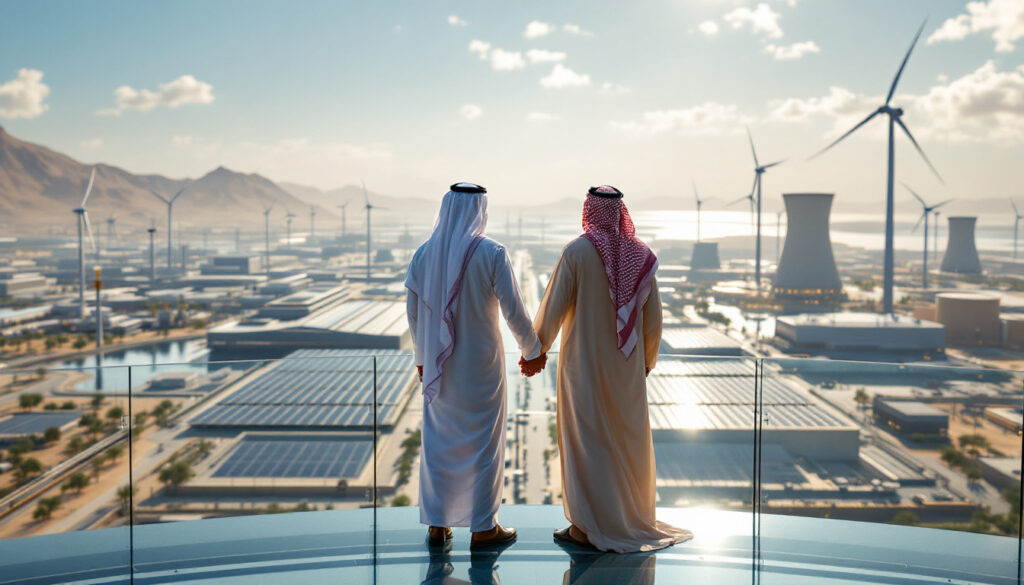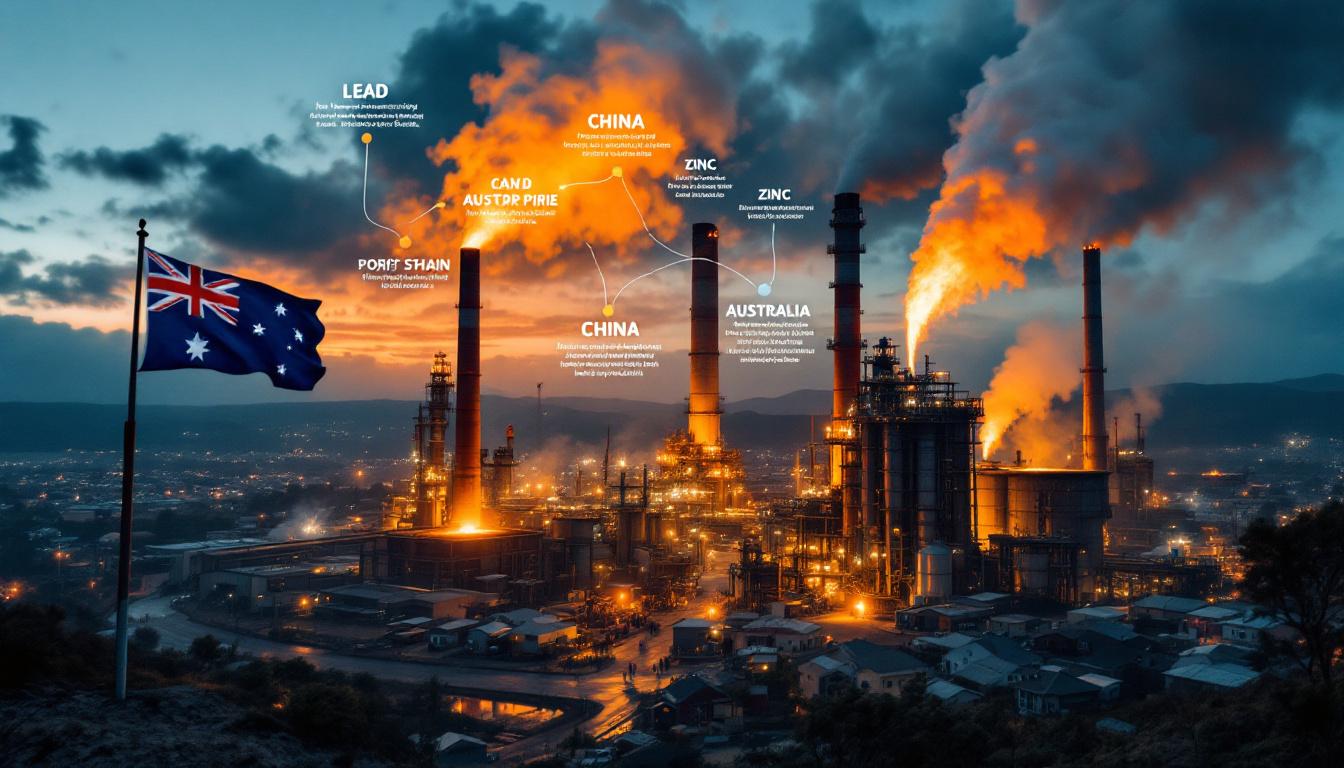Major Energy Deals Between the U.S. and Saudi Arabia: A Growing Partnership
The United States and Saudi Arabia have forged significant energy partnerships that reshape global energy dynamics. These agreements represent strategic cooperation between the world's largest oil consumer and one of its dominant producers. Their collaboration spans traditional oil agreements to cutting-edge renewable technologies, creating a multifaceted energy relationship that continues to evolve in response to global challenges.
The partnership has expanded beyond crude oil to include initiatives in nuclear energy, renewable resources, and technological innovation. This diversification reflects both nations' recognition of changing global energy landscapes while maintaining their positions as key players in international markets.
How Have U.S.-Saudi Energy Relations Evolved?
The Historical Foundation of Energy Cooperation
The U.S.-Saudi energy relationship dates back to 1933 when Standard Oil of California (now Chevron) first discovered oil in the Kingdom. This discovery marked the beginning of what would become one of the most significant energy partnerships in modern history. According to U.S. State Department archives, this initial connection laid the groundwork for decades of cooperation and interdependence.
As energy historian Daniel Yergin noted in his book The New Map (2020), "The 1945 Quincy Pact laid the foundation for 80 years of energy interdependence." This agreement between President Roosevelt and King Abdulaziz established the framework for American technical assistance in exchange for access to Saudi oil reserves.
The relationship has weathered numerous geopolitical storms, including the 1973 oil embargo, price wars, and regional conflicts. Through these challenges, both nations have recognized their mutual interests in maintaining stable oil price movements and strategic cooperation.
Shifting from Oil Dependency to Broader Energy Collaboration
Recent years have witnessed a significant evolution in bilateral energy relations. While crude oil remains central—with Saudi exports to the U.S. averaging 500,000 barrels per day in 2024 (EIA, 2024)—cooperation has expanded substantially to include renewable energy, nuclear power, and technological innovation.
This diversification reflects Saudi Arabia's Vision 2030 initiative, which aims to reduce oil dependency by targeting 50% renewable electricity generation by 2030 (Saudi Press Agency, 2023). For the United States, this broader engagement supports energy transition security through multiple sources while creating export opportunities for American technology and expertise.
The $10 billion PetroRabigh refinery, a joint venture between Aramco and Dow Chemical established in 2015, exemplifies this evolving relationship. Such projects demonstrate how bilateral energy cooperation has moved beyond simple crude oil transactions to include value-added products and technological collaboration.
What Major Energy Agreements Have Been Signed Recently?
Landmark Oil Production and Supply Agreements
Recent agreements include substantial crude oil supply commitments ensuring steady flows to American refineries. These arrangements provide Saudi Arabia with guaranteed market access while offering the U.S. greater energy security. The agreements include flexible delivery schedules and pricing mechanisms that benefit both parties during market volatility.
Disclaimer: Oil supply agreements are subject to market conditions and geopolitical factors that may affect implementation timelines and volumes.
Nuclear Energy Cooperation Framework
A groundbreaking nuclear cooperation framework established in 2025 creates pathways for American companies to provide nuclear technology, training, and materials to Saudi Arabia. According to World Nuclear News (2025), this framework includes provisions for Westinghouse to build two AP1000 reactors in the Kingdom.
This agreement includes strict safeguards and monitoring protocols aligned with International Atomic Energy Agency (IAEA) standards, while positioning U.S. firms competitively in Saudi Arabia's emerging nuclear sector. The deal enables technology transfer while maintaining nonproliferation standards through rigorous inspection regimes.
Renewable Energy Investment Partnerships
Multiple agreements have been signed facilitating American investment in Saudi renewable energy projects, with approximately $5 billion allocated for U.S. technology transfers in solar and hydrogen development (Saudi Gazette, 2024). These partnerships include joint ventures for solar farm development, wind energy infrastructure, and grid modernization.
At COP28, U.S. Climate Envoy John Kerry emphasized that "Green hydrogen collaboration is pivotal for net-zero goals," highlighting the importance of projects like the NEOM Green Hydrogen initiative supported by Air Products and ACWA Power. This project targets production of 1.2 million tons of green hydrogen annually by 2027 (NEOM, 2023).
The Sakaka Solar Plant, a 300 MW facility developed as a U.S.-Saudi joint venture between ACWA Power and First Solar (Reuters, 2023), demonstrates how American expertise in renewable technologies complements Saudi Arabia's abundant solar resources and ambitious clean energy targets.
How Do These Deals Impact Global Energy Markets?
Stabilizing Effect on Oil Prices
The strengthened U.S.-Saudi energy partnership has demonstrated a stabilizing effect on global oil markets. According to the International Monetary Fund (2024), OPEC+ production adjustments coordinated with U.S. input helped stabilize oil prices in the $75-85 per barrel range throughout 2024, despite significant regional tensions.
Fatih Birol, Executive Director of the International Energy Agency, noted that "U.S.-Saudi coordination is critical for balancing energy transition and security" (IEA Report, 2024). This coordination reduces price volatility and improves market predictability, benefiting both producers and consumers worldwide.
Creating New Market Opportunities
These agreements have opened significant market opportunities for American energy companies. U.S. firms secured approximately $7 billion in Saudi energy contracts in 2024 alone (Bloomberg, 2024). These contracts span equipment supply, technical services, and project management across Saudi Arabia's expanding energy sector.
A prime example is GE's $1.2 billion grid modernization deal with Saudi Electric (GE, 2023), which involves implementing smart grid technologies to improve efficiency and integrate renewable energy sources. Such projects facilitate technology transfer while creating high-skilled jobs in both countries.
Geopolitical Implications for Energy Security
The deepened energy partnership carries substantial geopolitical implications. For the United States, these agreements enhance energy security by diversifying supply sources and strengthening ties with a key Middle Eastern ally. For Saudi Arabia, the partnership provides technological access and investment needed for economic diversification while cementing its strategic importance to America.
A comparative analysis by the Center for Strategic and International Studies (CSIS, 2024) shows that U.S.-Saudi energy cooperation serves as a counterbalance to growing Chinese influence in Middle Eastern energy markets, highlighting the strategic dimensions of these commercial arrangements.
What Technologies Are Being Shared Through These Agreements?
Advanced Oil Recovery Techniques
The agreements include provisions for sharing enhanced oil recovery technologies that can increase production from mature fields. According to the Society of Petroleum Engineers (SPE, 2023), carbon dioxide injection and other enhanced recovery methods can boost recovery rates by 15-20% from conventional reservoirs.
American expertise in techniques like CO₂ injection, hydraulic fracturing adaptations, and reservoir modeling is being transferred to Saudi operators. These technologies help maximize recovery rates from existing reserves while potentially reducing the environmental footprint of extraction activities.
Clean Energy Innovation Exchange
A significant component involves clean energy technology exchange, including advanced solar panel manufacturing, energy storage solutions, and smart grid technologies. American companies are providing expertise in integrating renewable energy into existing grids while developing joint research initiatives on next-generation technologies.
The U.S. Department of Energy's Hydrogen Roadmap (2023) targets green hydrogen production costs of $1.50/kg by 2030, with Saudi Arabia's vast solar resources providing an ideal testing ground for these technologies. As Bill Gates of Breakthrough Energy noted in a 2024 interview, "Saudi solar potential can revolutionize green hydrogen production and create a new clean energy export industry."
Carbon Capture and Utilization Systems
The partnerships include substantial cooperation on carbon sequestration technology. According to Aramco (2024), joint pilot projects are targeting 2 million tons per year of CO₂ storage, making these among the largest CCUS initiatives globally.
These agreements facilitate the deployment of American carbon capture systems at Saudi industrial facilities while developing new applications for captured carbon in manufacturing and enhanced oil recovery. The MIT Energy Initiative's 2024 study on CCUS scalability in arid regions highlights the unique advantages of deploying these technologies in Saudi Arabia's geological formations.
How Do These Deals Address Climate Concerns?
Emissions Reduction Commitments
The energy agreements incorporate specific emissions reduction targets and implementation timelines. Both countries have joined the Global Methane Pledge (2021), committing to cut methane emissions by 30% by 2030. These commitments include methane leak detection and repair programs, flaring reduction initiatives, and energy efficiency improvements across production facilities.
The agreements establish monitoring mechanisms to track progress toward these goals, with regular reporting requirements and third-party verification protocols. This transparency helps ensure accountability while building confidence in the environmental benefits of these energy partnerships.
Green Hydrogen Development Initiatives
A cornerstone of the climate-focused agreements involves cooperation on green hydrogen production and utilization. American electrolyzer technology is being deployed alongside Saudi renewable energy to produce zero-carbon hydrogen for domestic use and export.
The NEOM Green Hydrogen Project represents the flagship initiative in this space, targeting production of 1.2 million tons of green hydrogen annually by 2027 (NEOM, 2023). This project positions both countries at the forefront of the emerging hydrogen economy while demonstrating a practical pathway for oil-producing nations to diversify into clean energy.
Circular Carbon Economy Framework
Aramco CEO Amin Nasser emphasized that "The circular carbon economy aligns growth with sustainability" (Reuters, 2024). This approach addresses emissions through a four-pronged strategy:
- Reduce: Improving energy efficiency and minimizing emissions at source
- Reuse: Capturing carbon for industrial applications
- Recycle: Converting CO₂ into valuable products
- Remove: Permanent geological storage of carbon
This holistic strategy combines American technological innovation with Saudi Arabia's industrial scale to develop commercially viable carbon management solutions. The World Bank's 2024 report on Saudi carbon credit initiatives further details how this framework is being implemented through market-based mechanisms.
What Economic Benefits Do These Agreements Bring?
Job Creation and Economic Diversification
The energy deals are projected to create approximately 10,000 high-skilled jobs in the United States from renewable technology exports alone (U.S. Commerce Department, 2024). For Saudi Arabia, these agreements support economic diversification goals by developing new industrial sectors and reducing oil dependency.
Lucid Motors' electric vehicle factory in Saudi Arabia, scheduled for completion in 2025, exemplifies how these energy partnerships extend into adjacent sectors like transportation and advanced manufacturing. Such projects create employment opportunities while transferring valuable skills and know-how.
Investment Flows and Market Access
The agreements facilitate substantial cross-border investment flows, with American companies gaining preferential access to Saudi Arabia's expanding energy market. Saudi sovereign wealth funds have correspondingly increased investments in U.S. energy infrastructure and technology companies, with the Public Investment Fund (PIF) allocating approximately $15 billion to U.S. energy startups (PIF Annual Report, 2024).
These investments create mutually beneficial financial ties while providing capital for innovative technologies that might otherwise struggle to secure funding. The reciprocal nature of these investment flows helps balance the partnership and creates stakeholders for continued cooperation in both countries.
Supply Chain Integration and Resilience
These partnerships strengthen global energy supply chains by integrating American and Saudi capabilities. Joint ventures in manufacturing, technology development, and logistics improve supply chain resilience while reducing costs. This integration creates competitive advantages for companies from both nations in global markets.
For critical materials like rare earth elements used in renewable technologies, these partnerships help diversify supply sources beyond China, enhancing economic security for both countries. This strategic dimension of supply chain cooperation extends beyond immediate commercial benefits to address longer-term geopolitical concerns.
How Are These Deals Structured Financially?
Public-Private Partnership Models
Many agreements utilize innovative public-private partnership structures that distribute risks and rewards between government entities and private companies. According to the Saudi Ministry of Finance (2024), approximately $3 billion in sovereign guarantees has been allocated for energy infrastructure projects under these models.
These partnerships enable larger-scale projects while providing appropriate incentives for efficiency and innovation. Government guarantees help secure financing while private sector discipline ensures commercial viability and market responsiveness.
Sovereign Wealth Fund Participation
Saudi sovereign wealth funds play a crucial role in financing these energy partnerships. Strategic investments from funds like the Public Investment Fund provide capital while securing technology access and market opportunities. These investments are structured to deliver both financial returns and strategic benefits for Saudi Arabia's economic transformation.
The PIF's $15 billion allocation to U.S. energy startups (PIF Annual Report, 2024) demonstrates this dual objective approach to investment, targeting both commercial returns and strategic technology access.
Export Credit and Development Finance Support
U.S. government agencies, including the Export-Import Bank and the U.S. International Development Finance Corporation (DFC), provide financing support for American companies participating in these energy partnerships. The DFC's $500 million loan facility for solar projects (DFC, 2025) represents one example of how government backing reduces investment risks while ensuring American companies can compete effectively for major contracts.
This government support is particularly important for emerging technologies like green hydrogen and advanced nuclear, where commercial financing may be difficult to secure due to perceived technology risks or long development timelines.
What Challenges Do These Energy Partnerships Face?
Geopolitical Tensions and Policy Shifts
The energy partnerships remain vulnerable to broader geopolitical tensions and policy shifts in both countries. According to the Energy Information Administration (EIA, 2024), oil price volatility in 2024 was exacerbated by conflicts in the Middle East and North Africa region, highlighting the potential impact of regional instability on energy cooperation.
Rachel Ziemba, energy security expert at the Center for a New American Security, warned that "Geopolitical tensions risk derailing tech transfer timelines" (2024 analysis). Changes in administration priorities, regional conflicts, or human rights concerns can impact implementation of even the most carefully structured agreements.
Market Volatility and Energy Transition Pressures
Global energy market volatility presents ongoing challenges to partnership implementation. Fluctuating oil prices, accelerating energy transition timelines, and changing technology economics require flexibility in agreement execution. Both countries must navigate these uncertainties while maintaining commitment to long-term objectives.
The rapid cost decline of renewable technologies creates both opportunities and challenges for these partnerships, requiring regular reassessment of project economics and technology choices.
Technological and Implementation Hurdles
Many agreements involve deploying emerging technologies that face technical and commercial challenges. Scaling carbon capture systems, integrating large renewable capacity, and developing hydrogen infrastructure all present implementation hurdles.
The partnerships include technical cooperation mechanisms and phased implementation approaches to address these challenges, but success will require sustained commitment and adaptability from both sides. Pilot projects and knowledge sharing become critical strategies for overcoming these technical barriers.
FAQ: U.S.-Saudi Arabia Energy Deals
How do these energy deals affect global oil prices?
The strengthened U.S.-Saudi coordination helps stabilize global oil markets by improving production transparency and supply predictability. According to the IMF (2024), this coordination has reduced price volatility while ensuring adequate supply to meet global demand, benefiting both producers and consumers worldwide.
When market disruptions occur, such as during regional conflicts, this coordination provides a mechanism for rapid response to prevent sustained price spikes or supply shortages.
What role do renewable energy projects play in these agreements?
Renewable energy constitutes a growing portion of the bilateral energy relationship, with multiple agreements focused on solar, wind, and green hydrogen development. These projects support Saudi Arabia's goal of generating 50% of its electricity from renewables by 2030 (Saudi Vision 2030 Progress Report, 2024) while creating export opportunities for American technology.
The Sakaka Solar Plant and NEOM Green Hydrogen Project demonstrate how these renewable initiatives are moving beyond planning stages to implementation, creating templates for future collaboration.
How do these deals impact America's energy independence?
Rather than reducing American energy independence, these agreements complement it by ensuring diverse supply options, creating export markets for U.S. technology, and strengthening a key strategic relationship. The partnerships represent energy interdependence rather than dependency.
American renewable technology exports to Saudi Arabia create domestic manufacturing jobs while supporting global climate goals—a win-win scenario that enhances rather than compromises U.S. energy security.
What safeguards exist for nuclear technology transfer?
The nuclear cooperation agreements include comprehensive safeguards to prevent proliferation risks, including monitoring protocols, inspections regimes, and restrictions on uranium enrichment and reprocessing. According to the IAEA's 2025 inspection agreement with Saudi Arabia, these measures ensure peaceful use while enabling civilian nuclear development.
These safeguards align with international standards and build upon successful U.S. nuclear cooperation with other countries in the region, creating a framework for responsible development of civilian nuclear capabilities.
How do these deals address human rights concerns?
The energy partnerships operate within the broader bilateral relationship where human rights issues are addressed through separate diplomatic channels. The agreements focus on commercial and technical cooperation while recognizing that energy security and human rights both remain important aspects of the overall relationship.
Transparency requirements in these agreements, particularly for public-private partnerships, help ensure that implementation adheres to international standards for corporate social responsibility and stakeholder engagement.
Further Exploration
Readers interested in learning more about U.S.-Saudi energy cooperation can explore related educational content from Oilprice.com, which regularly covers developments in global energy markets and international energy partnerships. The Center for Strategic and International Studies (CSIS) and the International Energy Agency (IEA) also publish detailed analyses of these energy relationships and their global implications.
Understanding these energy partnerships requires considering both their commercial value and their strategic importance in an era of rapid energy transition and geopolitical competition.
Ready to Spot the Next Major Mineral Discovery Before the Market?
Discover how savvy investors identify significant ASX mineral discoveries in real-time with Discovery Alert's proprietary Discovery IQ model, turning complex data into actionable trading opportunities. Visit our discoveries page to explore how historic mineral discoveries have generated substantial returns for early investors.




